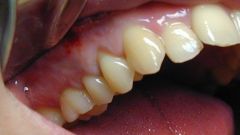First, detection of characteristic symptoms of the flux, it is mandatory to visit the office of a dentist. In order to choose the correct antibiotic therapy specialist assigns the test to identify the type of pathogen. As a rule, the development of flux contribute to staphylococcal and streptococcal infection. It should be noted that the choice of medications, dosage and duration of treatment mainly depend on the weight and age of the patient, presence of drug Allergy and the severity of the pathological process.
Stop suppurative process arising due to the formation of the flux, you can use antibacterial drugs.
"Amoxiclav - medication with wide spectrum of action. Has a fairly high efficiency in therapy of flux. Contains klavulanova acid, thanks to which there is a strengthening antibacterial properties of this drug.
"Tsifran" - combat the microorganisms which have led to the development of inflammation. Has a strong bactericidal and antimicrobial action. Its peculiarity lies in the fact that the dosage and duration of treatment depend directly on the symptoms of the disease.
"Ampiox" - is a combination drug because of ampicillin and oxacillin. One consequence of this formulation is the extension of the range of action of the drug. Considered the most effective antibiotic in the treatment therapy of flux.
"Doxycycline" - antibacterial agent tetracycline. Contributes to the inhibition of protein synthesis most germs, including streptococci and staphylococci.
"Lincomycin" - contains active ingredients that quickly eliminate destructive processes in the tooth and heal tissue. Drug works by the accumulation in the bone tissues teeth and gums, playing the role of immunity until dissolved. So after using this medication is the possibility of the resumption of purulent inflammation in the oral cavity is extremely small.
It is necessary to consider that antibiotics should not take less than a week and quit after improve well-being. Otherwise, it may cause drug resistance of microorganism that triggered the formation of flux. Therefore, when re-development of the disease the drug will not have the desired effects and lose effectiveness.
In addition to antibacterial agents additionally prescribe rinses and the use of anesthetizing drugs, immunomodulators.
First, the flux is characterized by the presence of a toothache, aggravated by chewing. In addition, there is swelling of the tissues surrounding the tooth and occur on the gum lump with purulent contents. In that case, if the aching tooth is on the upper jaw, there is swelling of the cheeks and lips may be swelling of the suborbital region and age. If lower, then possible swelling of the chin area, cheeks, a significant increase in the lymph nodes under the jaw. In addition, the patient body temperature rises and there is a General malaise. With the development of acute forms of the flux occurs swelling of the gums, which can move on the upper lip, and then spread to soft tissues of the neck and face. Is running disease can cause death.
Antibiotics in the suppression of the flux
Stop suppurative process arising due to the formation of the flux, you can use antibacterial drugs.
"Amoxiclav - medication with wide spectrum of action. Has a fairly high efficiency in therapy of flux. Contains klavulanova acid, thanks to which there is a strengthening antibacterial properties of this drug.
"Tsifran" - combat the microorganisms which have led to the development of inflammation. Has a strong bactericidal and antimicrobial action. Its peculiarity lies in the fact that the dosage and duration of treatment depend directly on the symptoms of the disease.
"Ampiox" - is a combination drug because of ampicillin and oxacillin. One consequence of this formulation is the extension of the range of action of the drug. Considered the most effective antibiotic in the treatment therapy of flux.
"Doxycycline" - antibacterial agent tetracycline. Contributes to the inhibition of protein synthesis most germs, including streptococci and staphylococci.
"Lincomycin" - contains active ingredients that quickly eliminate destructive processes in the tooth and heal tissue. Drug works by the accumulation in the bone tissues teeth and gums, playing the role of immunity until dissolved. So after using this medication is the possibility of the resumption of purulent inflammation in the oral cavity is extremely small.
It is necessary to consider that antibiotics should not take less than a week and quit after improve well-being. Otherwise, it may cause drug resistance of microorganism that triggered the formation of flux. Therefore, when re-development of the disease the drug will not have the desired effects and lose effectiveness.
In addition to antibacterial agents additionally prescribe rinses and the use of anesthetizing drugs, immunomodulators.
What are the symptoms of flux
First, the flux is characterized by the presence of a toothache, aggravated by chewing. In addition, there is swelling of the tissues surrounding the tooth and occur on the gum lump with purulent contents. In that case, if the aching tooth is on the upper jaw, there is swelling of the cheeks and lips may be swelling of the suborbital region and age. If lower, then possible swelling of the chin area, cheeks, a significant increase in the lymph nodes under the jaw. In addition, the patient body temperature rises and there is a General malaise. With the development of acute forms of the flux occurs swelling of the gums, which can move on the upper lip, and then spread to soft tissues of the neck and face. Is running disease can cause death.


